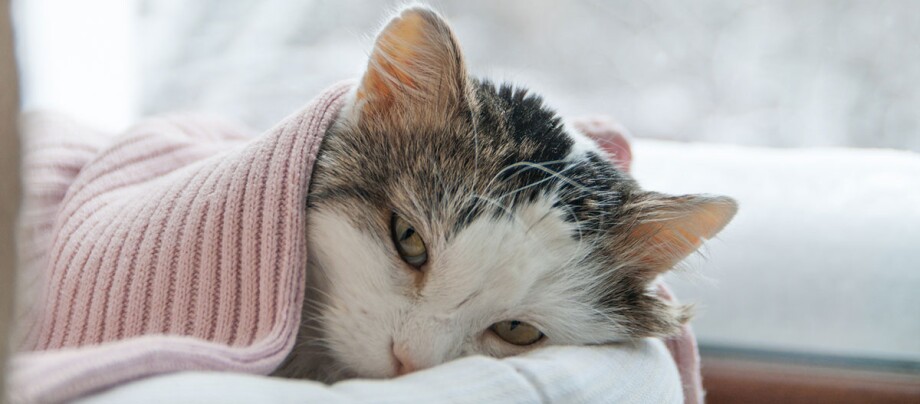Feline Panleukopedia: How This Infectious & Dangerous Virus Effects Your Cat
17.10.2022 - Reading time: 5 minutes

Epidemic - when we as humans hear this word, we think of contagious and serious diseases. But there are also diseases in the animal kingdom that can spread as epidemics and are life-threatening for the infected creatures. But don't worry: although the dreaded feline epidemic is a widespread and threatening disease, it is treatable thanks to modern medicine. Today, you can reliably protect your cat from the disease by vaccinating it in time. Even in the case of acute illness, timely countermeasures can save a cat's life.
What triggers feline epidemic disease?
Feline panleukopenia is caused by a tiny pathogen: the feline panleukopenia virus, so vets speak professionally of panleukopenia; colloquially the disease is known as feline epidemic, feline plague or also aleukocytosis. This virus is very closely related to parvovirus B19, which causes a similar clinical picture in dogs and canines. The tricky thing is that the virus is extremely long-lived. It can survive for up to a year at room temperature on objects such as baskets, toys and the like, and is resistant to most common disinfectants. New infection can therefore occur at completely unexpected times and places: No direct contact with an infected animal is necessary. Transmission occurs through contact with infected excreta such as faeces or nasal secretions with mucous membranes. For example, if the cat inspects the droppings of an infected animal, it can easily become infected. Ectoparasites such as lice or fleas can also carry the pathogen from one animal to another. The risk of infection by the small, resistant virus is very high: If it gets into a group of cats, all non-immune, i.e. unvaccinated animals will become infected. Therefore there is a latent danger that feline epidemic disease will spread in animal shelters, boarding kennels or catteries that are not providing adequate medical care.
What are the symptoms of feline epidemics?
After an incubation period of about two to six days, general signs of malaise usually appear first: tiredness, reluctance to eat, loss of fluids. Fever episodes may occur: The body temperature rises sharply to 41°C, then drops again and rises abruptly once more. Vomiting and conjunctivitis may also occur. All these signals are initially quite unspecific accompanying symptoms. What is particularly bitter about this is that in a so-called peracute course of the disease, the animal may not even show any preceding signs of illness, but suddenly falls ill and can die of shock. The actual point of attack of the virus is the intestinal, bone or lymphatic vessels. The sick animal suffers from bloody diarrhoea – again excreting large amounts of virus – and the reduction of white blood cells. This in turn leads to a serious weakening of the immune system. Feline epidemic disease causes multiple symptoms in the intestinal tract such as dying tissue in the intestinal crypts and loss of intestinal villi. The virus can even infect unborn foetuses and cause brain disorder, cerebellar ataxia or blindness. Through infection in the womb, even newborn kittens can be carriers of the virus.
How can I help with feline epidemics?
The virus primarily attacks animals whose immune system is not yet fully developed. Thus, it mainly attacks kittens and young cats up to two years of age or weakened animals. However, adult cats are also at risk, although less frequently. If the symptoms of feline epidemic break out, the sick animal must immediately receive veterinary treatment: the further course of the disease can lead to the death of the animal within a few hours, especially in kittens, if medical countermeasures are not initiated immediately.
The laboratory can detect the virus microscopically; there is also a rapid test for analysing faeces. Detections of antibodies in tissue samples from the small intestine and spleen also serve to document the virus. The cat’s blood count is particularly important: if the white blood cell count drops dramatically, a cure is hardly possible.
Veterinary treatment of an infected animal starts with the administration of antibiotics; serum antibodies and interferons (immune-stimulating proteins) are applied against the virus itself. If the treatment starts early enough, the animal’s chances of recovery are quite good. Nevertheless, the disease is not to be taken lightly: the mortality rate is 25-75%, depending on the general condition of the animal and the particular strain of the virus. However, even after recovery from the disease, the danger is not completely eliminated: Once a cat has contracted feline epidemic disease, it continues to excrete the virus for a long time, so it does not relapse, but it continues to spread the pathogen. These cats should not have contact with unvaccinated conspecifics or be outdoor cats.
The same applies to feline epidemics: timely vaccination protects the animal from infection. A start and booster vaccination at kitten age and revaccinations at yearly intervals will protect your cat from infection.
I
Is feline epidemic disease also contagious for humans?
As far as this point is concerned, you can breathe a sigh of relief. The feline panleukopenia virus is not compatible with human cells. There is therefore no danger of feline panleukopenia spreading to humans as a zoonosis. However, animals outside the feline family, such as raccoons and minks, are at risk, and as wild carriers of the virus, they can potentially infect or be infected by a cat.



